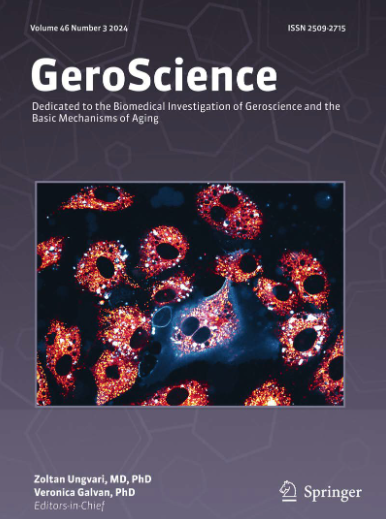九种生物年龄指标与心血管疾病死亡率的相关性和预测值:两项前瞻性队列研究的筛选和验证
IF 5.4
2区 医学
Q1 GERIATRICS & GERONTOLOGY
引用次数: 0
摘要
生物年龄(BA)比实足年龄更准确地反映衰老过程。本研究旨在评估9种BA指标与死亡结局的相关性和预测价值。BA测量采用宜兴队列研究(YCS; N = 4128)的数据,并在裕廊队列研究(JCS; N = 16652)中进行了外部验证。临床指标与全因死亡之间的剂量-反应关系采用限制性三次样条分析进行评估。然后使用九种不同的算法将统计上显著的预测因子整合到BA估计中。计算BA和实足年龄之间的差异,称为delta年龄(DA),并使用Cox比例风险模型评估其与死亡率结果的关系。9种DAs与CVD死亡相关的风险比(HR)大于全因死亡,其中Klemera和双法2 (KDM2)得出的DA与CVD死亡的相关性最强(YCS: HR(95% CI) = 1.325 (1.060-1.656);Jcs: hr (95% ci) = 1.167(1.101 ~ 1.236);P < 0.05)和全因死亡(yc:人力资源(95% CI) = 1.203 (1.075 - -1.346);Jcs: hr (95% ci) = 1.089 (1.050-1.129);p < 0.05)。将基于kdm2的DA纳入传统危险因素模型显著提高了CVD死亡的预测,反映在净重分类改善(YCS: NRI = 7.9%, JCS: NRI = 9.1%, P < 0.001)和综合判别改善(YCS: IDI = 0.4%, JCS: IDI = 0.7%, P < 0.001)。我们的研究结果支持基于kdm2的衰老测量可以作为识别心血管疾病事件和全因死亡高风险人群的补充工具。本文章由计算机程序翻译,如有差异,请以英文原文为准。
Association and predictive values of nine biological age measures for cardiovascular disease mortality: screening and validation from two prospective cohort studies.
Biological age (BA) reflects the aging process more accurately than chronological age. This study aimed to evaluate the associations and predictive values of nine BA measures for mortality outcomes. BA measures were developed using data from the Yixing Cohort Study (YCS; N = 4,128) and externally validated in the Jurong Cohort Study (JCS; N = 16,652). Dose-response relationships between the clinical indices and all-cause death were assessed using restricted cubic spline analysis. Statistically significant predictors were then integrated into BA estimates using nine different algorithms. The difference between BA and chronological age, termed delta age (DA), was calculated, and its association with mortality outcomes was assessed using Cox proportional hazards models. The hazard ratios (HRs) of the association of the nine DAs with mortality were greater for CVD death than all-cause death, with the DA derived from the Klemera and Doubal Method 2 (KDM2) showing the strongest association with CVD death (YCS: HR(95% CI) = 1.325 (1.060-1.656); JCS: HR(95% CI) = 1.167(1.101-1.236); P < 0.05) and all-cause death (YCS: HR(95% CI) = 1.203(1.075-1.346); JCS: HR(95% CI) = 1.089 (1.050-1.129); P < 0.05). Incorporating KDM2-based DA into the traditional risk factors model significantly improved the prediction of CVD death, as reflected by net reclassification improvement (YCS: NRI = 7.9%; JCS: NRI = 9.1%; P < 0.001) and integrated discrimination improvement (YCS: IDI = 0.4%; JCS: IDI = 0.7%; P < 0.001). Our findings support that KDM2-based aging measures could serve as a complementary tool for identifying people at high risk of CVD events and all-cause death.
求助全文
通过发布文献求助,成功后即可免费获取论文全文。
去求助
来源期刊

GeroScience
Medicine-Complementary and Alternative Medicine
CiteScore
10.50
自引率
5.40%
发文量
182
期刊介绍:
GeroScience is a bi-monthly, international, peer-reviewed journal that publishes articles related to research in the biology of aging and research on biomedical applications that impact aging. The scope of articles to be considered include evolutionary biology, biophysics, genetics, genomics, proteomics, molecular biology, cell biology, biochemistry, endocrinology, immunology, physiology, pharmacology, neuroscience, and psychology.
 求助内容:
求助内容: 应助结果提醒方式:
应助结果提醒方式:


